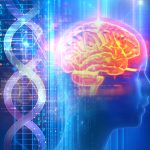
Autism and attention-deficit hyperactivity disorder (ADHD) share changes in the same genes, according to researchers from iPSYCH, Denmark’s largest psychiatry research project.
In Denmark, approximately one percent of schoolchildren have autism and two to three percent are diagnosed with ADHD. Autism and ADHD can share certain common symptoms. For example, children with either disorder can demonstrate violent or aggressive behaviors, be impulsive, and have problems in school and with social relations.
The new study, published in the journal Nature Neuroscience, reveals that the similarities between the two diagnoses can be linked to changes in the same genes. The study is the largest to date of rare mutations in the genome of people with ADHD and autism.
The researchers analyzed the genes of approximately 8,000 people with autism and/or ADHD, and 5,000 people without either of the two disorders, all from Denmark. The study also incorporated additional data from approximately 45,000 international control subjects who did not have any psychiatric disorders.
“The very fact that mutations are found to the same extent and in the same genes in children with autism and in children with ADHD, points towards the same biological mechanisms being involved,” said Dr. Anders Børglum, professor at Aarhus University, principal investigator at iPSYCH and one of the leading researchers behind the study. The study was carried out in collaboration with the Broad Institute and Harvard.
“This is the first time that the genome has been mapped so comprehensively for both ADHD and autism, and the discovery that children with ADHD have the same amount of deleterious gene mutations in their DNA as children with autism is both striking and quite surprising,” Børglum said.
The findings point directly towards which biological causal mechanisms are shared by ADHD and autism.
“In the study, the gene that is most frequently affected by mutations in people with ADHD or autism is the so-called MAP1A gene. The gene is involved in the formation of the physical structure of nerve cells — their inner ‘skeleton’, so to speak — and is important for the development of the brain,” Børglum said.
This is the first time that this gene has been linked to the development of ADHD and autism, and the mutations found by the researchers give a significantly increased risk of developing autism and/or ADHD.
“We discovered an increased burden of mutations that destroy or severely affect the MAP1A gene in those with ADHD and autism, while very few of the control subjects had such changes in the gene,” said Børglum.
This means that the risk of ADHD and autism increases by more than 15 times for people who carry such a mutation.
“The study shows that many more genes for ADHD and autism can be identified directly by studying more people in a similar way with extensive DNA sequencing, thereby providing a more complete picture of the biological causal mechanisms and possible approaches to medical treatment,” said Børglum.
Source: Aarhus University
* This article was originally published here






